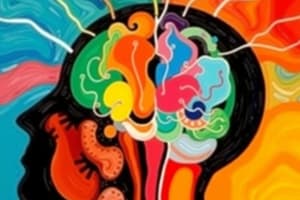Podcast
Questions and Answers
What are the primary functions of the Medulla, Pons, and Cerebellum in the Hindbrain?
What are the primary functions of the Medulla, Pons, and Cerebellum in the Hindbrain?
Medulla: vital functions, breathing, and heart rate; Pons: movement, breathing, sleeping, and waking; Cerebellum: balance and muscle control
How do the midbrain and the Reticular Formation interact to regulate consciousness and arousal?
How do the midbrain and the Reticular Formation interact to regulate consciousness and arousal?
The midbrain connects the brain stem and brain, and the Reticular Formation screens information to prevent overload, facilitating consciousness, arousal, and muscle tension
What are the primary functions of the Thalamus and Hypothalamus in the Forebrain?
What are the primary functions of the Thalamus and Hypothalamus in the Forebrain?
Thalamus: processes sensory information and sends it to relevant parts of the brain; Hypothalamus: regulates emotions and maintains internal environment (hunger, thirst, sleep)
What are the differences in functional specialization between the left and right cerebral hemispheres?
What are the differences in functional specialization between the left and right cerebral hemispheres?
How do the primary motor cortex, Broca's Area, and Association Areas in the Frontal Lobe contribute to complex mental functioning?
How do the primary motor cortex, Broca's Area, and Association Areas in the Frontal Lobe contribute to complex mental functioning?
What are the two main components of the nervous system, and what are the primary functions of each?
What are the two main components of the nervous system, and what are the primary functions of each?
What are the three main divisions of the Peripheral Nervous System, and what are their respective functions?
What are the three main divisions of the Peripheral Nervous System, and what are their respective functions?
What are the four main functions of the brain, and how do they contribute to overall nervous system function?
What are the four main functions of the brain, and how do they contribute to overall nervous system function?
What are the unique physical characteristics of the brain, and how do they contribute to its protection and function?
What are the unique physical characteristics of the brain, and how do they contribute to its protection and function?
How does the brain's ability to regulate vital body functions contribute to overall health and well-being?
How does the brain's ability to regulate vital body functions contribute to overall health and well-being?
Flashcards are hidden until you start studying




